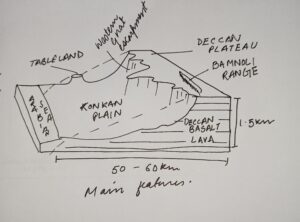Roadmap for Answer Writing Introduction Begin with the definition of a biome. Mention that biomes are large ecological regions characterized by specific climatic conditions, plant life, and animal species. List the major biomes: Forest, Grassland, Desert, Tundra, and Aquatic (Freshwater and Marine). Body: 1. Forest ...
Answer: The endogenic and exogenic forces causing physical stresses and chemical actions on earth materials and bringing about changes in the configuration of the surface of the earth are known as geomorphic processes. While, diastrophism and volcanism are endogenic geomorphic processes, weathering,Read more
Answer: The endogenic and exogenic forces causing physical stresses and chemical actions on earth materials and bringing about changes in the configuration of the surface of the earth are known as geomorphic processes. While, diastrophism and volcanism are endogenic geomorphic processes, weathering, mass wasting, erosion and deposition are exogenic geomorphic processes. The differences between the two processes are as follows:
| Parameter | Endogenic Processes | Exogenic Processes |
| Location | Inside the surface of the Earth. | Outside the surface of the Earth. |
| Driving Forces | The energy emanating from within the earth, mostly by radioactivity, rotational and tidal friction, and primordial heat from the origin of the earth, is the main force behind endogenic geomorphic processes. | The exogenic processes derive their energy from the atmosphere determined by the ultimate energy from the sun and also the gradients created by tectonic factors. |
| Effects | The energy due to geothermal gradients and heat flow from within induces diastrophism and volcanism in the lithosphere. | Gravitational force acts upon all earth materials having a sloping surface and tends to produce movement of matter in a downslope direction. |
| Nature | Constructive forces as they create relief features on the surface of the Earth. | Destructive forces result in destruction via weathering, denudation, and erosional processes. |
| Examples | Earthquakes, Volcanoes, etc. | Wind, Rivers, Glaciers, etc. |
Significance of Weathering: Weathering is the action of elements of weather and climate over the earth’s materials. There are a number of processes within weathering that act either individually or together to affect the earth’s materials in order to reduce them to a fragmental state.
- Weathering processes are responsible for breaking down the rocks into smaller fragments and preparing the way for the formation of not only regolith and soils but also erosion and mass movements.
- Weathering is an important process in the formation of soils. Biodiversity depends upon vegetation, which in turn, is dependent upon the depth of weathering mantles.
- Weathering aids mass wasting, erosion, and reduction of relief. Also, changes in landforms are a consequence of erosion.
- Weathering of rocks and deposits helps in the enrichment and concentrations of certain valuable ores of iron, manganese, aluminum, copper, etc., which are of great importance to the national economy.
- Weathering processes are conditioned by many complex geological, climatic, topographic and vegetative factors.




 Volcanic eruptions, tectonic uplifts as well as long term erosions are some of the factors that have shaped Deccan Plateau presently with its elevated terrain, deep river valleys and fertile soils.
Volcanic eruptions, tectonic uplifts as well as long term erosions are some of the factors that have shaped Deccan Plateau presently with its elevated terrain, deep river valleys and fertile soils.
Model Answer Introduction Biomes are large ecological areas defined by their climate, vegetation, and wildlife. Earth is home to a variety of biomes, each with unique environmental characteristics. The major biomes include forests, grasslands, deserts, tundras, and aquatic biomes, each of which inflRead more
Model Answer
Introduction
Biomes are large ecological areas defined by their climate, vegetation, and wildlife. Earth is home to a variety of biomes, each with unique environmental characteristics. The major biomes include forests, grasslands, deserts, tundras, and aquatic biomes, each of which influences the types of organisms that can live there.
Forest Biomes
Desert Biome
Grassland (Savannah) Biome
Tundra Biome
Aquatic Biomes
Conclusion
Each biome is distinguished by its unique climate, vegetation, and animal life. These differences have shaped the development of specialized flora and fauna, allowing species to adapt and thrive in their respective environments.
See less